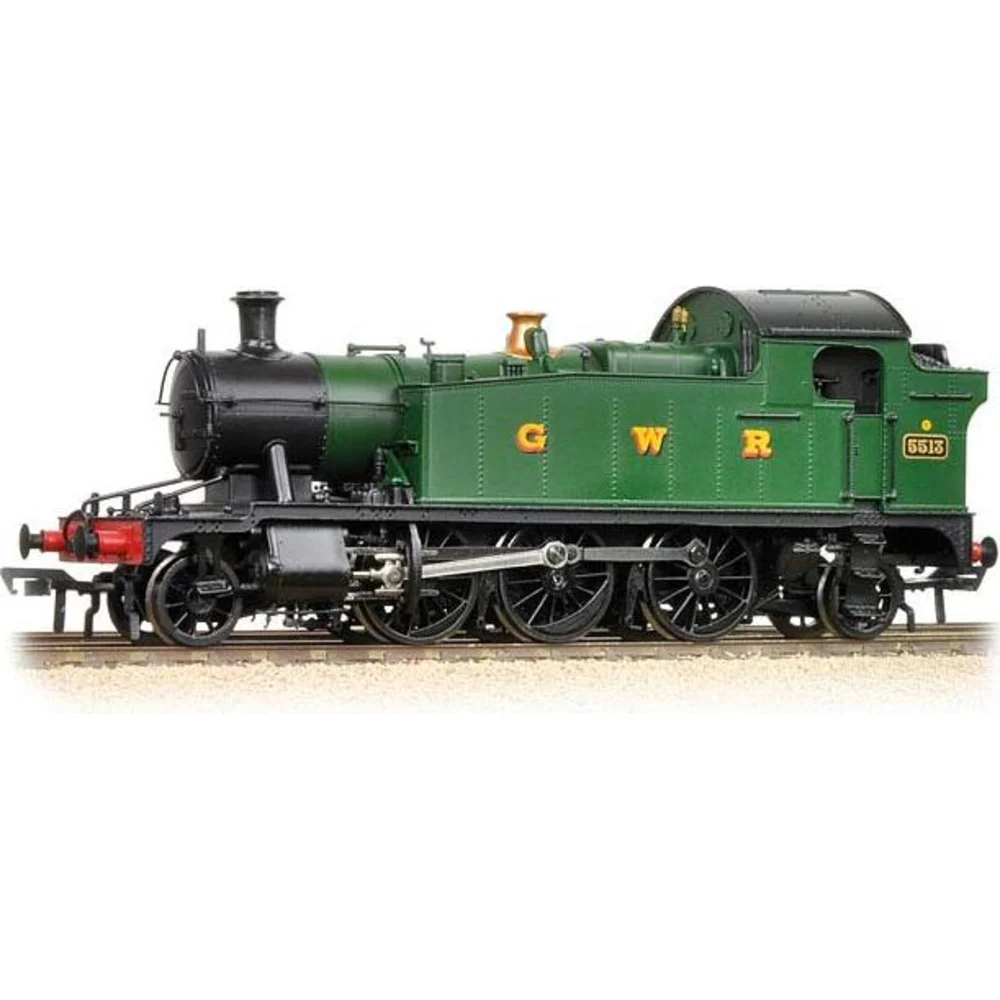Bachmann 32-139
Great Western Railway 4575 5513 Great Western Railway Green
Tooling
In 2012, Bachmann Branchline significantly upgraded its OO gauge model of the Great Western Railway (GWR) 4500 Class “Small Prairie” tank locomotive. This revision built upon the original 2003 tooling, addressing feedback from modellers and aligning with the growing demand for digital control compatibility. The upgrade introduced a factory-fitted DCC socket, improved detailing, and refinements to the mechanism, ensuring the model remained competitive in an evolving market.
Tooling Features
- Scale: OO (1:76)
- Construction: Die-cast chassis for weight and stability, precision-moulded plastic bodyshell with enhanced rivet and panel detail.
- Detailing: Separate handrails, finer pipework, improved cab interior, sprung buffers, and NEM coupling pockets.
- Couplings: Standard tension-lock couplers in NEM pockets for easy replacement.
Mechanical & Electrical
- Motor & Drive: Smooth-running can motor with worm drive to the centre axle, providing reliable performance.
- Weighting: Metal chassis ensures good adhesion and realistic running qualities.
- Minimum Radius: Compatible with 1st radius curves (approx. 371 mm).
- Lighting: No factory lighting fitted.
DCC Capability
The 2012 upgrade introduced an 8-pin NMRA DCC socket, making digital conversion straightforward. A blanking plug was fitted for DC operation, and the motor was fully isolated from the chassis. This was a major improvement over the hard-wired design of the 2003 tooling.
Liveries Produced
The revised tooling was offered in a range of authentic liveries, including GWR green, BR black (early emblem), and BR lined green (late crest). Weathered and sound-fitted versions followed in later years.
Reviews & Commentary
Model railway magazines and online reviewers praised the upgrade for its improved ease of DCC installation and enhanced detailing. While the mechanism remained similar to the earlier version, the addition of sprung buffers and finer fittings was well received. Social media discussions highlighted the model’s smooth running and attractive finish, though some enthusiasts noted that the tooling was still based on the original 2003 design rather than a complete retool.
Interesting Notes
- The 2012 upgrade paved the way for later sound-fitted releases and factory-weathered options.
- This tooling continued to serve as the basis for Bachmann’s 4575 and 55xx variants until the full retool in the 2020s.
Bachmann's Description & Specifications
The 4575 ‘Prairie Tanks’ were some of the GWR’s most versatile locomotives and this Bachmann Branchline model brings the same versatility to any OO Scale layout set in the Western Region.
The charm of the prototype is captured in the Branchline model which features a highly detailed, precision moulded bodyshell that is adorned with a multitude of separate components, from the metal handrails and tank vents to the lamp irons, tank fillers, lubricators and whistle. Sprung metal buffers are carried on each bufferbeam and inside the small but perfectly formed bunker, a realistic coal load is fitted.
The chassis, powered by a substantial 3 pole motor, carries an 8 pin DCC decoder socket and is adorned with details like the springs, brake blocks, brake rigging and sand boxes – accompanied by separate wire sandpipes. Each of the front and rear pony trucks is sprung to provide superb track holding and NEM coupling pockets are moulded integrally; guard irons are also incorporated giving the trucks an authentic appearance. The livery is applied to the usual high standard you would expect from a Bachmann model, with rich paintwork adorned with finely printed lettering and numbering to produce a model that is fit for service straight out of the box.
Class & Prototype
- Class: Great Western Railway 4575
- Traction: Steam
- Built: 1927-1929
- Total Built: 100
- Running Number: 5513
Operator & Livery
- Operator: Great Western Railway
- Livery: Green
- Era: 3 - The big 4 – LMS, GWR, LNER & SR
The Great Western Railway (1835-1947) was Britain's most innovative railway company, engineered by Isambard Kingdom Brunel with his revolutionary 7ft ¼in broad gauge system. Known affectionately as "God's Wonderful Railway" and the "Holiday Line," the GWR connected London Paddington with the West Country, Wales, and Birmingham through 3,800 miles of superbly engineered routes.
Renowned for its Brunswick green locomotives, chocolate and cream carriages, and engineering excellence centred at Swindon Works, the GWR pioneered advanced steam technology under chief mechanical engineers Daniel Gooch, George Jackson Churchward, and Charles Collett. The company's legendary locomotive classes—including Castle, King, Hall, and Manor—established performance standards that influenced British locomotive design for decades.
The only "Big Four" railway to retain its original identity through the 1921 grouping, the GWR maintained its distinctive corporate culture until nationalisation in 1947. Today, the company's engineering legacy lives on through extensive preservation efforts, heritage railways, and detailed model railway recreations that celebrate the finest traditions of British steam railway operation.
